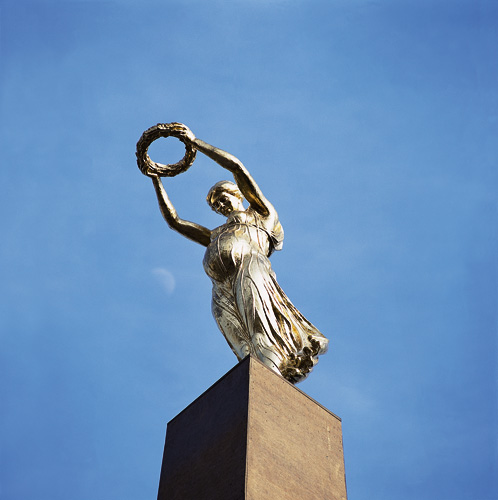A feminist reaction to public monuments, definitely worth reading more:
Among the projects that represent Iveković’s feminist position, Lady Rosa of Luxembourg is her most public statement. In 1998, when the artist was invited to participate in Manifesta, a biennial exhibition of contemporary art held that year in Luxembourg, she proposed a civic intervention, titled Pregnant Memory, that would involve removing the gilded, larger-than-life neoclassical Nike (the allegorical female figure of victory) from the war memorial known as Gëlle Fra (Golden lady): the figure would have been taken from the top of its obelisk in Constitution Square, in the center of the capital city, and installed on the premises of a shelter for abused women. Gëlle Fra was designed in 1923 in memory of the volunteers who fought with the Allies in World War I. In 1940, during the Nazi occupation, the statue was dismantled and placed in storage, and in 1985 it was re-erected with a plaque including the names of the fallen soldiers of World War II. Iveković’s proposal was deemed too controversial and remained unrealized.
Three years later the artist was invited back to rethink her initial proposal as part of an exhibition organized by Casino Luxembourg and the Musée d’Histoire de la Ville de Luxembourg. It was then that she created Lady Rosa of Luxembourg, a full-scale replica of the Gëlle Fra, installed within walking distance of the original, with three critical interventions: the new monument was dedicated to the Marxist philosopher and activist Rosa Luxemburg, who was executed in Germany in 1919 for her radical political ideas; Nike was turned into a visibly pregnant woman; and the original commemorative plaque honoring male heroism was replaced with texts in French, German, and English: "LA RÉSISTANCE, LA JUSTICE, LA LIBERTÉ, L’INDÉPENDENCE" (Resistance, justice, liberty, independence); "KITSCH, KULTUR, KAPITAL, KUNST" (Kitsch, culture, capital, art); and "WHORE, BITCH, MADONNA, VIRGIN.”
Women played a significant role in Luxembourg’s resistance movement during World War II, but their fight has been kept out of official history; instead they are represented simply as symbolic bearers of national history, as idealized, allegorical figures such as Nike. By making Nike pregnant and renaming her after a real woman, Iveković restored the female figure to its rightful historical position. Lady Rosa of Luxembourg provoked a fierce debate that played out in newspaper headlines, on television shows, and in hundreds of articles and Internet discussions. The most violent opposition focused not on the pregnant figure but on the plaque; the displacement of ideals of male bravery with words that include abusive terms regularly used to describe women evidently touched a nerve. Iveković had flouted memorial conventions, tying everyday feminine dissidence to past resistance.
text from here.

No comments:
Post a Comment